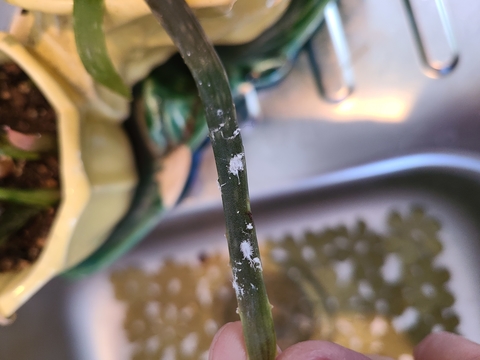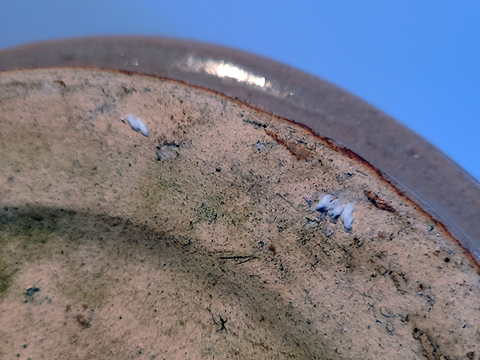And suddenly it’s fall! Time to start bringing in those houseplants that have thrived outdoors over the summer. Before bringing a plant indoors, it’s important to make sure you’re not bringing in anything but the plant.
What are mealybugs?
Outdoors, insect pests have natural enemies — birds, weather, other insects — but indoors they can thrive while feeding on your plants. Mealybugs (Pseudococcus spp.) are common houseplant pests. While the adult males are winged and tiny, the adult females are easy to see. They have segmented bodies that look fuzzy and are covered in wax.
Though there are both male and female mealybugs, these insects can reproduce asexually without mating. This means you can have a high population of mealybugs in a relatively short time. Most species lay 100 to 200+ eggs in cottony egg sacs attached to plant parts and can have two to six generations a year depending on where they are living. In warm climates and indoors, all stages of mealybugs — egg, nymph and adult — may be present at the same time.
Mealybugs are sucking insects that feed on leaves, buds, flowers and stems. They leave behind discolored leaves and honeydew, a clear and sticky excrement that can grow sooty mold. The sucking action and the sooty mold can be detrimental to a plant, causing it to decline. Flower buds tend to drop off before blooming when affected by mealybugs, reducing the plant’s beauty and productivity.
Mealybugs may seem slow, but they actually move quickly. Notice the long filaments in the above video.
Housecleaning your houseplants
Inspecting and cleaning plants before introducing them to other plants in your house can reduce the chances of pests like mealybugs from taking up winter residence.
- Clear away debris from the soil surface of your potted houseplant.
- Prune back stems to restore the plant’s form and remove dead leaves and spent flowers.
- Wipe off the pot and wash the saucer in hot soapy water. (I have found mealybugs living on the underside of saucers, especially unglazed terracotta. Ugh.)
- Wash small plants in the sink. Larger plants can be washed in a shower or with a sprayer on your garden hose. Blast the undersides of the leaves to clear off pests as well as egg masses, dirt, cobwebs, etc.
- Treat with low-impact pesticides labeled for houseplants and indoor ornamentals such as insecticidal soap, horticultural oil and neem oil.
- It can be challenging to get rid of 100% of insect pests the first time, so keep scouting your plants on a regular basis and removing pests or treating plants as needed.
Repot your plant
Before bringing a plant inside is a good time to repot it. While you have the plant out of the pot, turn the plant around and upside down and look for mealybugs and other pests on the underside of the leaves. If you find insects, webs or egg masses, remove them manually; wash them off or wipe them off with a damp paper towel or cotton swab.
- Is your plant top-heavy? Does it tip over easily? Then a larger pot is needed.
- Does the plant’s root ball dry out quickly or does water flow out of the pot quickly when watering it? The plant is likely pot-bound (more roots than soil) and would benefit from being repotted. Loosen up the root ball before putting it in new soil.
- Choose a new pot that has good drainage and is about 2 to 3 inches wider than the old one.
- Loosen the roots and replant at the same soil depth.
- Water well enough to saturate the soil completely.
When to give up
Sometimes, no matter what you do, a plant can become so infested that it becomes a risk to the rest of your plant collection and you may get tired of treating it. I have a couple like that in my collection and they are destined for the compost pile. I see it as protecting the rest of my plants and the opportunity to add something new to my collection!
Read more about managing insects on indoor plants.
Flint, M. L. Pest Notes: Mealybugs. UC ANR publication 74174. University of California Statewide IPM Program. March 2016. Accessed 12 October 2023. https://ipm.ucanr.edu/PMG/PESTNOTES/pn74174.html
Permission is granted to news media to republish our news articles with credit to University of Minnesota Extension. Images also may be republished; please check for specific photographer credits or limited use restrictions in the photo title.



